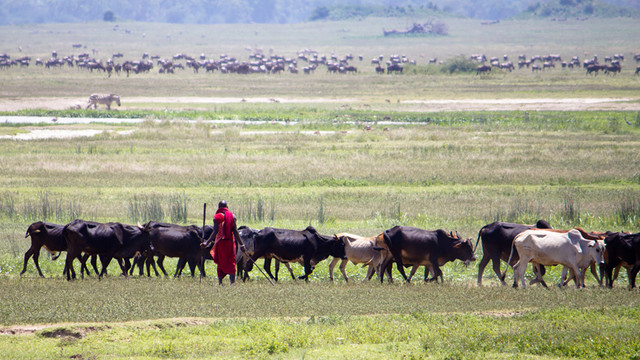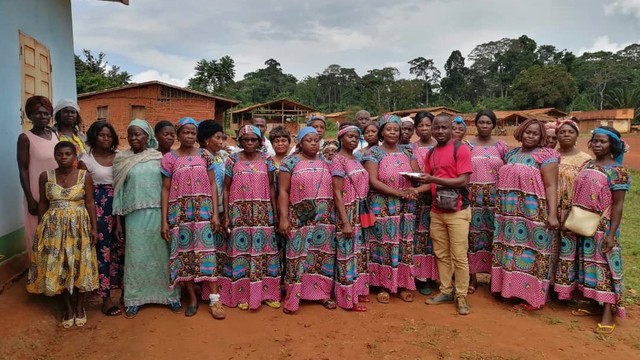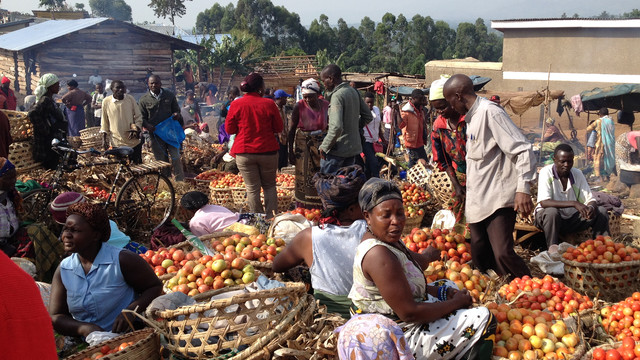Five ways to support women’s climate leadership for locally-led action
Calls for women climate leaders are growing louder. But more work is urgently needed to get women, at all levels, into the heart of climate planning and decision-making processes. During last month’s CBA16 international conference, a diverse group of women leaders brought forward concrete recommendations for creating leadership roles for women, and for empowering these women as agents of change.

Woman tending to her land in Yanonge, Democratic Republic of Congo (Photo: Axel Fassio/CIFOR-ICRAF, via Flickr, CC BY-NC-ND 2.0)
From community-level meetings to international policy discourse, women are repeatedly overlooked and excluded from planning and decision making to advance climate action.
Women bring deep knowledge and experience to the climate crisis, as well as solutions based on the specific priorities and needs of women and girls. Women bring diversity to leadership roles, enhancing the quality of decision-making. This is key for responding to the climate crisis.
Women, particularly viewed through an intersectional lens, are disproportionally affected by climate change. It is the right of people, particularly the most affected, to have their say in decisions that affect their lives and in designing solutions to address the risks they face.
There are increasing demands for a shift in the power balance. But more support for women climate leaders, at all levels, is urgently needed.
During last month’s 16th International Conference on Community Based Adaptation (CBA16), and as part of Climate Investment Funds’ (CIF) initiative to advance women's climate leadership, IIED, EnGen Collaborative and CIF hosted a session bringing together a diverse group of women leaders. These leaders were working in grassroots organisations, constituency-based organisations, government organisations and multilateral development banks and shared their perspectives and concrete recommendations for strengthening women’s climate leadership.
Contributions came from Omaira Bolaños, of Rights and Resources Initiative (RRI); Chitembo Kawimbe Chunga, of the Zambian Ministry of Green Economy and Environment; Nina Kolybashkina and Eirini Pitta, of Climate Investment Funds; Naseem Shaikh, of Swayam Shikshan Prayog, India and Huairou Commission; and Zonibel Woods, of the Asian Development Bank.

(Left to right and top to bottom) Zonny Woods, Nina Kolybashkina, Naseem Shaikh, Omaira Bolaños, Eirini Pitta and Chitembo Kawimbe Chunga
Supporting women’s climate leadership: five recommendations
1. Challenge structural barriers such as lack of land rights
Systemic barriers, such as gender inequalities and power imbalances in all areas of social, economic and political life limit the full and equal recognition of women as agents of change in climate solutions. These systemic barriers need to be addressed and removed.
One structural barrier is the lack of land property rights; women, for example, own less than 20% of the world’s land.
A recent report from RRI highlights that national laws and regulations on the rights of Indigenous and rural women to inheritance, community membership, community-level governance and community-level dispute resolution are consistently unjust, falling far below legal requirements.
Naseem Shaikh explained: “Most women don't have land access, or land ownership in their names. They can't access banking services or government schemes, but, still, they do 80% of the work in the agriculture sector.”
Chitembo Kawimbe Chunga echoed the importance of addressing structural barriers, including land access: “Being deliberate and intentional about addressing the multiple barriers women face, that’s when you start seeing real transformation happen in our societies.”
Nina Kolybashkina highlighted: “In the last few years, at CIF we realised that, unless we address the structural, institutional and normative barriers to equality, we will not change the systems that create those inequalities. We have raised our ambition to ensure that all new projects CIF is supporting are gender transformative.”
2. Support women’s leadership within Indigenous, Afro-descendent and local communities
Women are not one homogeneous group. It is vital to recognise intersectional oppressions and struggles that different groups of women face and prioritise support to those experiencing systemic barriers.
Omaira Bolaños highlighted: “Women from Indigenous and Afro-descendant communities experience mutually reinforcing structural forms of discrimination, marginalisation and human rights violations based on gender, class, ethnicity, race, origin, customs and socioeconomic status. The many and complex barriers women face limit their self-determination, their control over natural resources, the way they interact, their voices being heard.
Despite this, they make invaluable contributions to climate change mitigation and adaptation, preserving traditional knowledge, and supporting human and tenure rights. For example, Afro-descendant and local communities manage and conserve community territories that comprise over 50% of the world’s land that support up to 2.5 billion people.
"These systemic barriers must be addressed and their leadership role in climate action must be supported.”
Climate Investment Funds has a financing model that delegated decision-making under its dedicated grant mechanism to Indigenous People and local communities, also ensuring that women are prioritised as beneficiaries. For example, in Ghana almost half of sub-projects are women-led, one-third by migrant women.
3. Get more finance directly to women and women’s organisations
Providing direct access to finance for women-led initiatives can enable greater participation in climate action. Bolaños highlighted that, overall, Indigenous women’s groups receive less than 1% of all recorded human rights global funding. To repair the gap in direct funding, grassroots women organisations have launched a call to action so that climate finance does not leave these groups behind.
The low levels of funding women receive is one issue. Added to this are the many obstacles women’s organisations face in accessing finance. Looking specifically at climate finance, only around a third of climate finance projects take account of gender equality (PDF), and too little is spent at the local level.
Getting resources directly into the hands of women is instrumental for gender transformative climate action, as Zonibel Woods explained: “We need to have gender responsive climate finance at all levels. So that means directly investing in projects that will bring transformational changes to women's lives − projects that don’t just consider gender mainstreaming but intentionally dedicate resources to women at the community level.”
Removing obstacle for access to finance for female entrepreneurs is equally important – CIF’s experience in Tajikistan demonstrates that with adjusting loan conditions and providing capacity building, gender equality in accessing finance for resilience and adaptation activities can be achieved.
4. Demand and secure equal representation in decision-making
Equal representation in decision-making structures is fundamental to strengthening women’s leadership.
Chunga shared an example from Zambia where the constitution supports women’s participation in development and sets out that women should be given decision-making roles including in government and quasi-government institutions.
“We need to be deliberate and intentional to ensure that women have a space in decision-making, a space in championing actions around climate change or actions in any development space,” she said.
5. Invest in women’s groups and engage them as equal partners in decision-making
Investing in women’s groups, particularly grassroots groups, demonstrates recognition of women as leaders and drivers of change, and empowers them to participate in decision-making processes.
Shaikh’s call was clear and direct: “We need to stop seeing women as victims but as equal partners... We have to invest in women. Without investment we will not see results. So I invite donors, partners and policymakers to invest in women's groups, especially grassroots women who are at the forefront of their communities. Provide them with flexible financing mechanisms and invite them as equal partners at all stages − from policy design to implementation.”
Eirini Pitta talked about experiences from CIF’s pilot programme on climate resilience in promoting representation and leadership of women in governance/decision-making bodies, such as in community development groups (CDG) in Nepal, where women held 42% of decision-making positions. “Through their membership and participation in the CDG committees, where they were able to voice their concerns on project schemes, the women earned the respect of their community,” she said.
An example of initiatives that give space for women’s grassroots organisations in decision-making is Asian Development Bank’s Community Resilience Partnership Program (CRPP). The programme supports countries in the region to scale up investments that address the nexus between poverty, climate change and gender. More initiative such as CRPP are needed.
Aligning with the principles for locally led adaptation
The theme of CBA16 was putting the principles for locally led adaptation (LLA) into practice.
These eight principles have been developed to strengthen effective, equitable, locally led adaptation.
Supporting women’s climate leadership speaks directly to the second LLA principle, seeking to address structural inequalities faced by women, youth, children, disabled and displaced people, Indigenous Peoples and marginalised ethnic groups.
Efforts to tackle gender-based inequalities and support women at the local level to participate in and lead adaptation decisions – and through this champion women as climate leaders − are fundamental for advancing effective and just locally led climate adaptation.
- Watch a full recording of the CBA16 session: What does women's climate leadership mean in the context of locally led adaptation?
This article was co-produced with inputs from speakers from the CBA16 session of women's climate leadership: Omaira Bolaños, Chitembo Kawimbe Chunga, Naseem Shaikh and Zonibel Woods, and from the IIED team: Anna Carthy, May Thazin Aung and Karen Wong Pérez.



